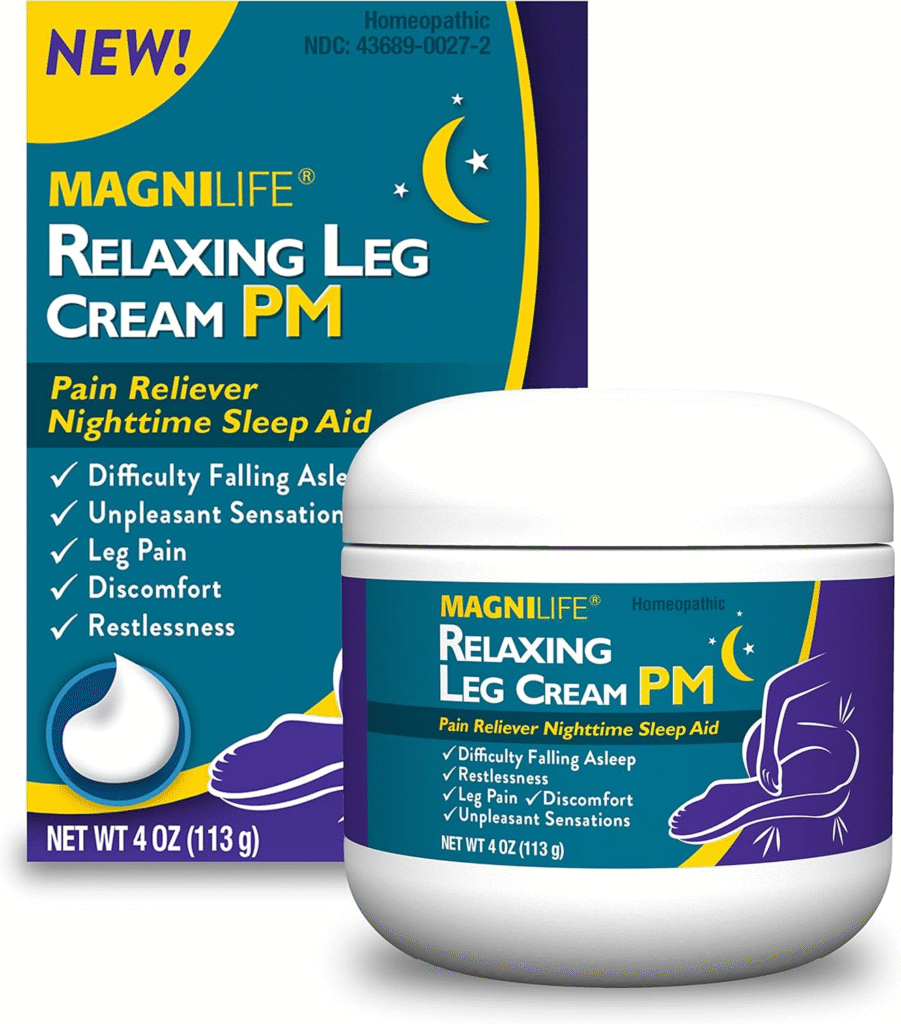Leg cramps can be incredibly disruptive, especially for women who experience them because of various factors like hormonal changes, pregnancy, or certain medications. Finding the right cream to reduce these painful muscle contractions is crucial for maintaining comfort and quality of life.
I’ve researched extensively to bring you a comprehensive guide to the most effective leg cramp relief creams tailored specifically for women’s needs.
Understanding Leg Cramps in Women
Women are particularly susceptible to leg cramps because of several factors unique to our physiology and life stages. Hormonal fluctuations during menstrual cycles, pregnancy, and menopause can all contribute to an increased frequency of leg cramps.
Additionally, certain medications, such as birth control pills or hormone replacement therapy, may exacerbate the issue.
Dehydration and electrolyte imbalances also play a significant role in the occurrence of leg cramps. Women who are physically active or those who don’t consume enough water and minerals throughout the day may find themselves more prone to these painful episodes.
Pregnancy brings its own set of challenges when it comes to leg cramps. The added weight and pressure on the legs, combined with changes in circulation and potential nutrient deficiencies, can lead to more frequent and intense cramping, especially during the third trimester.
Understanding the root cause of your leg cramps is essential in choosing the most effective cream for your situation. While topical treatments can provide significant relief, it’s also important to address any underlying issues that may be contributing to the problem.
Key Ingredients to Look For
When shopping for a leg cramp relief cream, certain ingredients stand out for their effectiveness in addressing muscle pain and spasms. Here are some of the most useful components to look for:
Magnesium
Magnesium is a mineral that plays a crucial role in muscle function and relaxation. Many women are deficient in magnesium, which can contribute to muscle cramps.
Topical magnesium creams can be absorbed through the skin, helping to relax muscles and prevent spasms.
Arnica
Derived from the arnica montana plant, this natural ingredient has been used for centuries to reduce pain and inflammation. Arnica-based creams can help reduce the soreness associated with leg cramps and promote faster recovery of the affected muscles.
Menthol
Menthol provides a cooling sensation that can distract from pain and increase blood flow to the affected area. This increased circulation can help relax tense muscles and reduce the duration of cramps.
Capsaicin
Extracted from chili peppers, capsaicin creates a warming effect that can soothe sore muscles. It works by depleting substance P, a neurotransmitter that sends pain signals to the brain, effectively reducing the sensation of pain over time.
Essential Oils
Various essential oils can provide both aromatherapeutic benefits and muscle relaxation. Lavender is known for its calming properties, while peppermint and eucalyptus can provide a cooling effect similar to menthol.
These natural oils can enhance the overall effectiveness of leg cramp relief creams.
Top Picks for Leg Cramp Relief Creams
After extensive research and consideration of user reviews, I’ve compiled a list of the top leg cramp relief creams that are particularly effective for women:
1. MagniLife Leg Cramp Relief Cream
MagniLife Leg Cramp Relief Cream has gained popularity among pregnant women and those suffering from nocturnal leg cramps. The cream’s magnesium-rich formula absorbs quickly into the skin without leaving a greasy residue, making it comfortable to use at any time of day or night.
One of the standout features of this cream is the addition of lavender oil, which provides a calming scent. This can be particularly useful for those who experience leg cramps at night, as the soothing aroma may help you relax and fall back asleep after applying the cream.
The fast-acting nature of MagniLife makes it an excellent choice for sudden onset cramps. Many users report feeling relief within minutes of application, which can be a game-changer when dealing with intense, unexpected muscle spasms.

2. Biofreeze Pain Relief Gel
While not marketed specifically for leg cramps, Biofreeze has become a go-to solution for many women dealing with muscle pain, including leg cramps. The menthol-based formula provides an immediate cooling sensation that can quickly reduce cramp discomfort.
Biofreeze is particularly effective for cramps related to exercise or overexertion. The cooling effect helps to reduce pain and reduces inflammation, which can be useful for recovery after intense physical activity.
The gel format of Biofreeze allows for easy application and quick absorption. It’s also available in a roll-on version, which can be convenient for targeted application to specific areas of the leg.

3. Motherlove Pregnant Belly Salve
Despite its name, Motherlove Pregnant Belly Salve is an excellent choice for pregnancy-related leg cramps. The blend of herbs like chamomile and calendula makes it gentle yet effective for addressing the unique muscle discomfort experienced during pregnancy.
The natural ingredients in this salve are safe for use during pregnancy, providing peace of mind for expectant mothers. The formula is free from artificial fragrances and preservatives, making it suitable for people who have sensitive skin.
While primarily marketed for belly care, many pregnant women have found relief from leg cramps by applying this salve to their calves and feet. The moisturizing properties of the salve can also help with the dry, itchy skin that often accompanies pregnancy.

4. Hyland’s Leg Cramps Ointment
For those who prefer a more homeopathic approach, Hyland’s Leg Cramps Ointment offers a natural solution to leg cramps and restless leg syndrome. This ointment uses a combination of natural ingredients to target leg discomfort without harsh chemicals.
Hyland’s has gained popularity among women going through menopause who experience nighttime leg discomfort. The gentle formula can be applied as needed without concerns about overuse or side effects.
The ointment’s texture allows for easy massage into the affected areas, which can provide additional relief through the physical act of rubbing the muscles. Many users find that the combination of the ointment’s ingredients and the massage technique provides comprehensive relief from leg cramps.

5. Penetrex Pain Relief Therapy
For women dealing with more intense, chronic leg pain, Penetrex Pain Relief Therapy offers a robust solution. The formula includes arnica, vitamin B6, and MSM (methylsulfonylmethane), which work together to provide deep, lasting relief.
While Penetrex is on the pricier side compared to some other options, many women find the investment worthwhile because of its effectiveness. The cream is designed to penetrate deeply into the muscle tissue, addressing pain at its source as opposed to just providing surface-level relief.
Penetrex is also versatile, effective for leg cramps but for various types of muscle and joint pain. This makes it a valuable addition to any pain management routine, especially for women who experience many types of muscle discomfort.

Application Tips for Maximum Relief
To get the most out of your leg cramp relief cream, consider these application tips:
Apply Before Bedtime
For those who experience nocturnal leg cramps, applying the cream before going to bed can help prevent nighttime episodes. This proactive approach allows the active ingredients to work throughout the night, potentially reducing the frequency and intensity of cramps.
Massage Deeply
When applying the cream, take the time to massage it deeply into the affected area. This confirms better absorption of the active ingredients and provides additional relief through the physical manipulation of the muscle.
Use firm, circular motions to work the cream into the skin and underlying muscle tissue.
Use After Warm Bath or Shower
Applying leg cramp relief cream after a warm bath or shower can enhance its effectiveness. The warmth from the water opens up your pores, allowing for better absorption of the cream’s ingredients.
Additionally, the relaxation provided by the warm water can complement the cream’s muscle-relaxing properties.
Consider Warm Compress
After applying the cream, consider wrapping the area with a warm compress. This can help the cream penetrate more deeply into the muscle tissue and provide additional soothing relief.
A warm compress can be particularly effective when used in conjunction with magnesium-based creams.
When to Seek Medical Advice
While leg cramp relief creams can be incredibly effective for managing occasional or mild leg cramps, it’s important to recognize when professional medical advice is necessary. If you’re experiencing frequent, severe cramps that don’t respond to over-the-counter treatments, it could be a sign of an underlying condition that requires medical attention.
For pregnant women experiencing persistent leg cramps, consulting with an obstetrician is crucial before trying new treatments. Pregnancy-related leg cramps can sometimes be a sign of nutrient deficiencies or other health issues that need to be addressed under medical supervision.
If leg cramps are accompanied by swelling, redness, or warmth in the affected area, it’s important to seek medical attention promptly, as these could be signs of a blood clot or other serious condition.
Additionally, if leg cramps are significantly impacting your quality of life or interfering with your daily activities, it’s worth discussing with a healthcare provider. They can help identify any underlying causes and recommend a comprehensive treatment plan that may include lifestyle changes, supplements, or prescription medications in addition to topical treatments.
Lifestyle Changes to Complement Topical Treatments
While leg cramp relief creams can provide significant relief, incorporating certain lifestyle changes can enhance their effectiveness and help prevent future episodes:
Stay Hydrated
Proper hydration is crucial for preventing leg cramps. Aim to drink at least 8 glasses of water per day, and increase your intake during hot weather or physical activity.
Dehydration can lead to electrolyte imbalances, which are a common cause of muscle cramps.
Regular Stretching
Incorporating a regular stretching routine, especially before bed, can help prevent nighttime leg cramps. Focus on stretches that target the calf muscles, hamstrings, and quadriceps.
Gentle yoga or Pilates can also be useful for overall muscle flexibility and strength.
Balanced Diet
Ensuring you’re getting enough potassium and magnesium in your diet can help prevent leg cramps. Foods rich in these minerals include bananas, avocados, leafy greens, nuts, and seeds. If you’re concerned about nutrient deficiencies, ask with a healthcare provider about potential supplements.
Supportive Footwear
Wearing supportive shoes and avoiding prolonged periods of standing can help reduce the likelihood of leg cramps. If you have a job that requires long hours on your feet, consider using compression socks to improve circulation in your legs.
Regular Exercise
Engaging in regular, moderate exercise can improve overall muscle health and circulation, potentially reducing the frequency of leg cramps. Low-impact activities like swimming, cycling, or walking are excellent options for maintaining muscle strength and flexibility without putting excessive strain on your legs.
The Science Behind Leg Cramp Relief Creams
Understanding how leg cramp relief creams work can help you choose the most effective product for your needs. These creams typically function through one or more of the following mechanisms:
Transdermal Absorption
Many leg cramp relief creams work through transdermal absorption, where the active ingredients are absorbed through the skin and into the underlying muscle tissue. This method allows for targeted relief without the need for oral medications that may have systemic effects.
Neurological Interference
Some ingredients, like capsaicin, work by interfering with pain signals sent to the brain. By depleting substance P, a neurotransmitter involved in pain perception, these creams can reduce the sensation of pain associated with leg cramps.
Improved Circulation
Ingredients like menthol and certain essential oils can increase blood flow to the affected area. This improved circulation can help relax tense muscles and flush out metabolic waste products that may contribute to cramping.
Muscle Relaxation
Magnesium-based creams work by promoting muscle relaxation at a cellular level. Magnesium is crucial for proper muscle function, and topical application can help address localized deficiencies that may contribute to cramping.
Natural Alternatives to Commercial Creams
For those who prefer a more natural approach or want to supplement their use of commercial creams, there are several home remedies that can provide relief from leg cramps:
Epsom Salt Soaks
Soaking in a warm bath with Epsom salts can help relax muscles and provide magnesium through transdermal absorption. Add 1-2 cups of Epsom salts to your bathwater and soak for 15-20 minutes.
Essential Oil Blends
Creating your own essential oil blend can be an effective and personalized approach to leg cramp relief. Mix a few drops of peppermint, lavender, and eucalyptus oils with a carrier oil like coconut or almond oil for a soothing massage blend.
Apple Cider Vinegar Compress
Applying a compress soaked in diluted apple cider vinegar to the affected area can help reduce leg cramps. The acetic acid in apple cider vinegar is thought to help replenish electrolytes and reduce muscle tension.
Turmeric Paste
Creating a paste with turmeric powder and water can provide anti-inflammatory benefits when applied topically. Turmeric contains curcumin, a compound known for its pain-relieving properties.
Ginger and Cayenne Pepper Rub
Mixing ginger and cayenne pepper with a carrier oil can create a warming rub that increases circulation and provides pain relief. Be cautious with this mixture, as it can be quite potent and may cause skin irritation in some people.
Choosing the Right Cream for Your Needs
With so many options available, selecting the best leg cramp relief cream for your specific situation can be overwhelming. Consider the following factors when making your choice:
Ingredient Sensitivity
If you have sensitive skin or allergies, pay close attention to the ingredient list. Opt for hypoallergenic formulas or those with natural ingredients if you’re prone to skin reactions.
Pregnancy Safety
For pregnant women, it’s crucial to choose creams that are specifically formulated to be safe during pregnancy. Always ask with your healthcare provider before using any new product.
Scent Preferences
Some creams have strong scents because of their active ingredients. If you’re sensitive to smells or prefer unscented products, look for fragrance-free options.
Absorption Rate
Consider how quickly you need relief. Some creams are designed for fast absorption and immediate action, while others may work more slowly but provide longer-lasting effects.
Lifestyle Compatibility
Think about when and where you’ll be using the cream. If you need something you can apply discreetly at work, a non-greasy, quick-absorbing formula might be best.
For nighttime use, a cream with a relaxing scent could be useful.
Potential Side Effects and Precautions
While leg cramp relief creams are generally safe for most users, it’s important to be aware of potential side effects and take necessary precautions:
Skin Irritation
Some people may experience skin irritation, redness, or itching when using topical creams. If you notice any adverse reactions, stop use and ask with a healthcare provider.
Allergic Reactions
Always perform a patch test before using a new cream extensively. Apply a small amount to a small area of skin and wait 24 hours to check for any allergic reactions.
Interaction with Medications
If you’re taking any medications, especially blood thinners or medications for diabetes, ask with your doctor before using leg cramp relief creams, as some ingredients may interact with your medications.
Overuse
While these creams can be very effective, it’s important not to rely on them as a sole solution for chronic leg cramps. Overuse can lead to decreased effectiveness over time.
Pregnancy and Breastfeeding
If you’re pregnant or breastfeeding, always ask with your healthcare provider before using any new topical treatments, even those marketed as pregnancy-safe.
The Future of Leg Cramp Relief
As research in this field continues, we can expect to see advancements in leg cramp relief treatments. Some promising areas of development include:
Targeted Delivery Systems
Future creams may incorporate advanced delivery systems that allow for deeper penetration of active ingredients into muscle tissue.
Personalized Formulations
With the rise of personalized medicine, we may see leg cramp relief creams tailored to individual needs based on factors like age, hormonal status, and specific health conditions.
Integration of Technology
Wearable devices that detect early signs of muscle tension and automatically dispense suitable amounts of cream could become a reality in the not-so-distant future.
Natural Ingredient Innovations
Ongoing research into plant-based compounds may lead to the discovery of new natural ingredients with powerful muscle-relaxing and pain-relieving properties.
People Also Asked
Can leg cramps be a sign of a serious condition?
While most leg cramps are benign, persistent or severe cramps can sometimes show underlying health issues such as peripheral artery disease, deep vein thrombosis, or electrolyte imbalances. If you experience frequent or severe leg cramps, it’s advisable to ask a healthcare professional.
Are there any foods that help prevent leg cramps?
Yes, certain foods can help prevent leg cramps by providing essential nutrients. Bananas, avocados, and leafy greens are rich in potassium and magnesium, which are important for muscle function.
Staying hydrated and consuming electrolyte-rich foods can also help.
How effective are magnesium supplements for leg cramps?
Magnesium supplements can be effective for some people in reducing the frequency and intensity of leg cramps, especially if there’s a magnesium deficiency. However, it’s important to ask with a healthcare provider before starting any supplement regimen.
Can pregnancy cause leg cramps?
Yes, leg cramps are common during pregnancy, especially in the third trimester. They can be caused by weight gain, changes in circulation, and pressure on blood vessels and nerves.
Proper nutrition, hydration, and gentle stretching can help reduce pregnancy-related leg cramps.
Is it safe to use leg cramp relief creams during pregnancy?
Some leg cramp relief creams are safe to use during pregnancy, but it’s crucial to choose products specifically formulated for pregnant women and to ask with your obstetrician before use. Avoid creams containing ingredients that may be harmful during pregnancy.
How long does it typically take for a leg cramp relief cream to work?
The onset of relief can vary depending on the product and individual factors. Some creams provide almost immediate relief within minutes, while others may take 15-30 minutes to fully take effect.
Consistent use over time may lead to better overall management of leg cramps.
Can dehydration cause leg cramps?
Yes, dehydration is a common cause of leg cramps. When the body is dehydrated, it can lead to an imbalance in electrolytes, which are crucial for proper muscle function.
Staying well-hydrated, especially during physical activity or hot weather, can help prevent cramps.
Are there any exercises that can help prevent leg cramps?
Regular stretching exercises, particularly for the calf muscles, can help prevent leg cramps. Gentle exercises like walking, swimming, or cycling can also improve circulation and muscle strength, potentially reducing the frequency of cramps.
Can wearing high heels contribute to leg cramps?
Wearing high heels for extended periods can contribute to leg cramps by altering your natural gait and putting extra strain on your calf muscles. If you often wear high heels, try to alternate with lower-heeled shoes and perform regular calf stretches.
Is it normal to experience leg cramps at night?
Nocturnal leg cramps are relatively common, especially in older adults. While occasional nighttime cramps are usually not a cause for concern, frequent or severe nighttime cramps should be discussed with a healthcare provider to rule out underlying conditions.
Key Takeaways
- Leg cramp relief creams can provide effective, targeted relief for women experiencing muscle spasms and pain.
- Key ingredients to look for include magnesium, arnica, menthol, capsaicin, and essential oils.
- Top picks for leg cramp relief creams include MagniLife, Biofreeze, Motherlove Pregnant Belly Salve, Hyland’s, and Penetrex.
- Proper application techniques, such as massaging deeply and using after a warm bath, can enhance the effectiveness of these creams.
- Lifestyle changes, including staying hydrated, regular stretching, and maintaining a balanced diet, can complement the use of topical treatments.
- Natural choices and home remedies can provide additional relief options for those preferring a more holistic approach.
- When choosing a cream, consider factors such as ingredient sensitivity, pregnancy safety, and lifestyle compatibility.
- Be aware of potential side effects and ask with a healthcare provider if you experience persistent or severe leg cramps.
Disclaimer
The information contained in this post is for general information purposes only. The information is provided by The Best Leg Cramp Relief Creams for Women and while we endeavor to keep the information up to date and correct, we make no representations or warranties of any kind, express or implied, about the completeness, accuracy, reliability, suitability or availability with respect to the website or the information, products, services, or related graphics contained on the post for any purpose.


